Text
BIBLIOGRAPHY - “ANIME FOODIES: LAID-BACK CAMP THE MOVIE”

This is the bibliography for our entry in the Anime Foodies series of panels, “Anime Foodies: Laid-Back Camp The Movie”. The sources include not only places from which we garnered background of the food we were cooking, but also sources that helped us determine how to craft our own version of the recipes we were creating.
This is the second Anime Foodies panel which has a formal bibliography of sources. Those marked with double asterisks are regular sources we’ve used in all of the panels in the series and are a good starting point for anyone interested in Japanese food and its history.
Bibliography:
Afro. Laid-Back Camp. Vol. 6, Yen Press, 2019.
Afro. Laid-Back Camp. Vol. 7, Yen Press, 2019.
“Anethum graveolens L.” Royal Botanic Gardens Kew, https://powo.science.kew.org/taxon/urn:lsid:ipni.org:names:837530-1.
Baker, Liren. “Taco Rice: Okinawa Taco Rice” Kitchen Confidante, https://kitchenconfidante.com/taco-rice-okinawa-taco-rice.
“Braised Yuba (Tofu Skins) with Vegetables” Sunberry Jam, https://sunberryjam.com/braised-yuba-with-vegetables/.
“Buttered Beere 1588” Oakden, https://oakden.co.uk/buttered-beere-1588/.
“Dutch Oven Roast Chicken” Self-Proclaimed Foodie, https://selfproclaimedfoodie.com/dutch-oven-roasted-chicken/#wprm-recipe-container-33149.
“Dutch Oven Roasted Chicken with Vegetables” Camping Adventures, https://adventures.camp/dutch-oven-roasted-chicken-with-vegetables/.
“Finnish Salmon Soup (Lohikeitto)” Skinny Spatula, https://skinnyspatula.com/salmon-soup-lohikeitto/.
Friesen, Katy June. “Where Did the Taco Come From?” Smithsonian Magazine, https://www.smithsonianmag.com/arts-culture/where-did-the-taco-come-from-81228162/.
Greg. “Hot Buttered Rum 2 Ways AND Fat Washing! | How to Drink.” YouTube, uploaded by How To Drink, 23 Nov. 2019, https://www.youtube.com/watch?v=cCbEwyntSCM.
“Hokkaido Salmon Hot Pot (Ishikari Nabe) 石狩鍋” Just One Cookbook, https://www.justonecookbook.com/salmon-hot-pot/.
“Hoto Noodle Soup from Yamanashi ほうとう” Just One Cookbook, https://www.justonecookbook.com/hoto-noodle-soup-yamanashi/#wprm-recipe-container-79243.
“Hōtō Noodle Soup (Hōtō Nabe)” RecipeTin Japan, https://japan.recipetineats.com/hoto-noodle-soup-hoto-nabe/.
“Houtou (ほうとう)” Food in Japan, https://www.foodinjapan.org/kanto/yamanashi/houtou/.
“How to make Houtou – Yamanashi local speciality noodle dish recipe” Japanese Cooking Class Tokyo, https://japanesecookingclasstokyo.wordpress.com/2014/01/03/how-to-make-houtou-yamanashi-local-speciality-noodle-dish-recipe/.
“How to Make the Best Tempura 天ぷら” Just One Cookbook, https://www.justonecookbook.com/tempura-recipe/.
Hua, Charlie. “Kiritanpo: Trying out one of Akita’s local specialties” Japan Travel, https://en.japantravel.com/akita/kiritanpo/55809.
“Hypomesus olidus” FishBase, https://fishbase.de/summary/Hypomesus-olidus.html.
“Hypomesus olidus” Integrated Taxonomic Information System – Report, https://www.itis.gov/servlet/SingleRpt/SingleRpt?search_topic=TSN&search_value=162031#null.
**Ishige, Naomichi. The History and Culture of Japanese Food. London, Kegan Paul Limited, 2001.**
“"Ishikari" Salmon Hot Pot (Ishikari nabe)” NHK World – Japan, https://web.archive.org/web/20201101192650/https://www.nhk.or.jp/dwc/food/recipe/kyou_12310.html.
“Ishikari Nabe Recipe (Salmon and Miso Hot Pot in Hokkaido)” Cooking With Dog, https://cookingwithdog.com/recipe/ishikari-nabe/.
“Japan-Mexico Relations (Basic Data)” Ministry of Foreign Affairs of Japan, https://www.mofa.go.jp/region/latin/mexico/data.html.
“Kiritampo Nabe (Rice Stick Hot Pot)” NHK World, https://web.archive.org/web/20180318093216/http://www.nhk.or.jp:80/dwc/recipes/detail/138.html.
“Kiritanpo (きりたんぽ)” Food in Japan, https://www.foodinjapan.org/tohoku/akita/kiritanpo/.
Laid-Back Camp. Directed by Yoshiaki Kyougoku. C-Station, 2018.
Laid-Back Camp Season 2. Directed by Yoshiaki Kyougoku. C-Station, 2021.
Laid-Back Camp The Movie. Directed by Yoshiaki Kyougoku. C-Station, 2022.
Miller, Max. “Making 400 Year Old Buttered Beere.” YouTube, uploaded by Tasting History with Max Miller, 10 Mar. 2020, https://www.youtube.com/watch?v=ZlMhZvOX2ps.
“Motsunabe” Japanese food style, https://jpnfood.com/recipe/meat/motsunabe.
“Motsunabe: How to Eat and the Best Restaurants in Fukuoka” Savor Japan, https://savorjapan.com/contents/discover-oishii-japan/motsunabe-how-to-eat-and-the-best-restaurants-in-fukuoka/.
“Motsunabe recipe もつ鍋” The Japanese Food Lab, https://thejapanesefoodlab.com/motsunabe/.
“Motsunabe (もつ鍋)” Food in Japan, https://www.foodinjapan.org/kyushu/fukuoka/motsunabe/.
“Okinawa Taco Rice and Cheese (Cafe Style)” Sudachi Recipes, https://sudachirecipes.com/okinawa-taco-rice/.
“Okinawa Taco Rice (Video) タコライス” Just One Cookbook, https://www.justonecookbook.com/taco-rice/.
“Recipe of Speedy Lightly Flavored! Hakata-style Motsunabe (Offal Hot Pot) with Soy Sauce Based Soup” Ground-Skillet, https://ground-skillet.web.app/734-recipe-of-speedy-lightly-flavored-hakata-style-motsunabe-offal-hot-pot-with-soy-sauce-based-soup/.
“Salmon Hot Pot (Ishikari Nabe)” RecipeTin Japan, https://japan.recipetineats.com/salmon-hot-pot-ishikari-nabe/.
“Salmon Soup” Happy Foods Tube, https://www.happyfoodstube.com/salmon-soup/.
Sam. “Aburi Technique for Fish” Chef Epic, https://chefepic.com/aburi-technique-for-fish/.
“Seared Salmon Sushi (Aburi)” Cooking with Cocktail Rings, https://cookingwithcocktailrings.com/seared-salmon-sushi-aburi/.
**Singleton Hachisu, Nancy. Japanese Farm Food. Kansas City, Andrews McMeel Publishing, 2012.**
**Singleton Hachisu, Nancy. Preserving the Japanese Way. Kansas City, Andrews McMeel Publishing, 2015.**
“【Smelt Tempura】 How to make Smelt tempura With technical explanation to stand fins” YouTube, uploaded by 逢禅天ぷらチャンネル / AIZEN TEMPURA CHANNEL 1 Oct. 2020, https://www.youtube.com/watch?v=H3KTXNGGAL4.
“Soy Milk Hot Pot 豆乳鍋” Just One Cookbook, https://www.justonecookbook.com/soy-milk-hot-pot-tonyu-nabe/.
“Taco Rice (タコライス)” No Recipes, https://norecipes.com/okinawa-taco-rice/.
“Tentsuyu” Oishi Washoku Recipes, https://www.oishi-washoku-recipes.com/tentsuyu.
“‘Tentsuyu’ (Tempura Dipping Sauce)” Hiroko’s Recipes, https://www.hirokoliston.com/tentsuyu-tempura-dipping-sauce/.
Turkell, Michael Harlan. “Foil Yaki Is the Best” Taste, https://tastecooking.com/foil-yaki-best/.
U.S. Fish and Wildlife Service. Wakasagi (Hypomesus nipponensis): Ecological Risk Screening Summary. 8 Nov. 2019, https://www.fws.gov/sites/default/files/documents/Ecological-Risk-Screening-Summary-Wakasagi.pdf.
“What is the “King Tacos” which is loved by Okinawan?” Okinawa Labo, https://okinawa-labo.com/en/okinawa-taco-rice-1966.
**Wondrich, David. Imbibe! From Absinthe Cocktail to Whiskey Smash, A Salute in Stories and Drinks to “Professor” Jerry Thomas, Pioneer of the American Bar. Updated and Revised Edition. New York City, TarcherPerigee, 2015.**
“〆まで美味しい ごま豆乳鍋つゆ ストレート” Mizkan, https://www.mizkan.co.jp/product/group/?gid=07101.
“簡単タコライス” Lettuce Club, https://www.lettuceclub.net/recipe/dish/22978/.
“王道タコライス” Delish Kitchen, https://delishkitchen.tv/recipes/196315721972580774. “簡単!すぐ出来!タコライス レシピ・作り方” Kurashiru, https://www.kurashiru.com/recipes/80ca4e93-29d6-422a-8168-cf409ac46d23.
#nos anime#camping food#camping#food#laid back camp#yuru camp#anime#anime foodies#anime food#yurucamp#laid back camp the movie#anime bibliography#bibliography
28 notes
·
View notes
Text
Ishikari Nabe with Yuba (Makes 5 Servings)
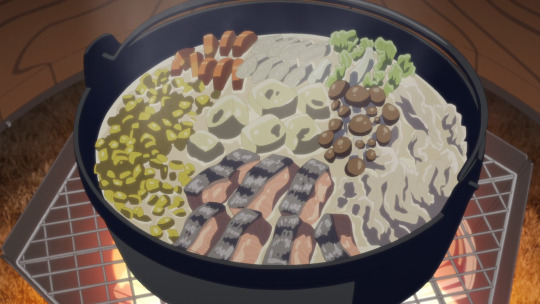
We bring you this recipe from our panel, “Anime Foodies: Laid-Back Camp The Movie”.
After the first, Scandinavian inspired salmon soup of the evening, Aoi brings over a previously hidden second pot containing something more traditionally Japanese: a hot pot. This Ishikari nabe she and Nadeshiko prepare is a classic Hokkaido nabe using salmon and miso that is perfect for the winter. As is not uncommon for our group, however, they decide on some additional, personal touches to the hot pot in for form of milk, yuba – tofu skin – and houtou to finish everything off.
5 Cups – Dashi
2 Medium – Carrot
1 Ear – Corn
1 Small – Russet Potato
¾ Lb. Skin-On – Salmon
2 oz. – Shimeji Mushrooms
4-5 Large Leaves – Napa Cabbage
8 – Green Onion Bases (Negi)
4 3-Inch Sections – Dried Tofu Skin Sticks (Fresh Tofu Skin)
3 TBSP – Miso
2 TBSP - Mirin
2 Cups – Whole Milk
3 TBSP – Unsalted Butter
200 Grams Plus Some Extra – Flour
7 TBSP – Water
At home, mix your flour and water in a large bowl and stir until a rough dough is formed.
Move to a floured work surface and knead the dough for a few minutes until it is pretty smooth.
Place the dough ball back into the bowl, cover, and let rest for 10 minutes.
After the rest, further flour the work surface and roll out the dough with a rolling pin into a rectangle to about 3-4 mm thick.
Sprinkle the top of the dough with additional flour, fold the rolled-out dough into thirds, and cut 1 cm thick noodles from the flattened dough.
Sprinkle the noodles with additional flour and store in a container in the cooler to take to the campsite.
Once on site, at least 6 hours before cooking, take your tofu skin and put into a container of water to rehydrate.
When it is time to make the hotpot, peel the carrots and chop them into bite-sized pieces, slice the salmon into 7 large nuggets, separate the shimeji and chop off any dirty bases, cut the green onion bases into large lengths, and wash and chop the napa cabbage leaves into large chunks.
Place the dashi in the hotpot pot over high heat to bring to a boil.
As that boils, peel the potato and cut into large bite-sized pieces.
Once the dashi is boiling, add the potatoes, yuba, and the ear of corn, cover, reduce the heat to medium, and simmer for 5 minutes.
After this simmers for 5 minutes, remove the ear of corn and slice the kernels off the cob.
Now slide the potato and yuba together in the dashi and add the carrots, salmon, shimeji, green onion, napa cabbage, and corn into their own sections.
Cover and continue to simmer for 5 minutes.
As this simmers, get your mirin, milk, and butter out and take your miso and place it into a large ladle.
When the simmering finishes, dunk the ladle into the broth to get some in there and, using chopsticks or a fork, muddle the dashi into the miso until most of the chunks are gone and you have a thick slurry.
Dump this slurry, the mirin, milk, and the butter into the stock, cover the pot, and lightly shake the pot to get the ingredients mixed in with the rest of the liquid.
Cover again, simmer another 5 minutes, turn off the heat, and the hotpot is ready to eat.
Once the solid chunks in the hotpot are all or mostly gone, turn the heat back on high and grab the houtou from its container.
Once at a boil, add the houtou, allow it to come back to a boil, and then reduce the heat to medium and cover.
Simmer for 15 minutes – adding additional water to the leftover broth if necessary – cut the heat, and serve.


Optional/Notes:
If you don’t feel like messing with the houtou, you can use any flat dried noodles of your choice. Keep in mind that you will almost certainly need to add additional water if using dried noodles.
Any kind of dashi will work for this. We used a kombu/katsuobushi dashi made at home and brought in jars, but powdered dashi made on site would also work fine.
2 oz. of shimeji is half of the standard packs you’ll find it in at grocery stores.
You can use any miso you choose, but we used a dark, brown rice miso, so you may need extra miso if you’re using something milder.
The yuba can be kept in water to soak for up to a day without concern, so this can be prepared even further ahead of time or before going camping entirely depending on when it will be eaten.
If you have access to and are using fresh yuba, no soaking is required and it can be added into the nabe with the salmon and other ingredients.
#anime#camping food#food#camping#nos anime#laid back camp#yuru camp#anime foodies#anime food#yurucamp#laid back camp the movie
10 notes
·
View notes
Text
Salmon Soup (Makes 5 Servings)
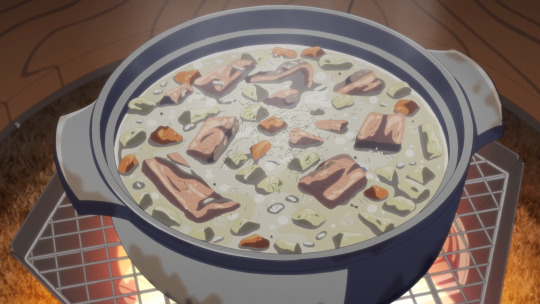
We bring you this recipe from our panel, “Anime Foodies: Laid-Back Camp The Movie”.
During the construction of the campsite in Yamanashi, our characters spend the night to give the campground a test run. Nadeshiko and Aoi are assigned to feed the group and stumble upon a tremendous sale on salmon which they take advantage of for a selection of dishes for the evening. This first recipe we see them create is a play on a Finnish soup called lohikeitto.
6 Cups - Water
1 ¼ Pound Skin-Off – Salmon
7 – Black Peppercorns
2 – Bay Leaves
1 Medium – White Onion
4 Medium – Carrots
2 Small – Russet Potatoes
1 TSP – Dried Dill
1 TSP – Kosher Salt
1/2 Cup – Heavy Cream
Bring the water to a boil over high heat.
As the water boils, peel the carrots and chop these and the onions into a large dice.
Once the water is boiling, add the peppercorns, bay leaves, onions, and carrots; cover; reduce the heat to medium; and cook for 5 minutes.
As this is cooking, peel the potatoes and chop into large, bite-sized pieces.
After the 5 minutes are up, add the potatoes, cover, and cook for another 8 minutes.
As this is cooking, check the salmon for bones and slice into 10 large nuggets.
After the 8 minutes are up, add the salmon, salt, cream, and dill; reduce the heat to medium low; cover; cook for a final 5 minutes, and serve.
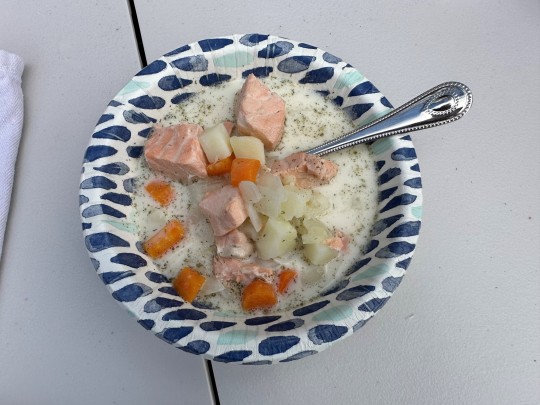
Optional/Notes:
If you use skin on salmon, make sure to check for any leftover scales on the skin before slicing it.
If you want a bit of a richer taste to the soup, you can substitute the water for a fish stock though this may reduce the amount of salt you need to add.
The small number of peppercorns don’t add a noticeable pepper flavor, so these can be crushed or ground if you want more pepper flavor to the soup.
If you would like to use fresh dill, increase the amount to 1 TBSP.
#anime#camping#camping food#nos anime#food#laid back camp#anime foodies#yuru camp#yurucamp#anime food#laid back camp the movie
47 notes
·
View notes
Text
Aburi Salmon (Makes 5 Servings)

We bring you this recipe from our panel, “Anime Foodies: Laid-Back Camp The Movie”.
As our characters sit around the campfire on their campsite test run, Chiaki takes advantage of the bevy of salmon at their disposal to roast some chunks over the fire and enjoy it with sake. While she calls this “aburi”, it is technically something a little different (though no less delicious).
1 Pound, Skin Off – Salmon
4 Pinches – Kosher Salt
Check the salmon for any leftover bones and slice into 10 large nuggets.
Lay the salmon nuggets on a plate and sprinkle with two pinches of salt on each side.
Secure the salmon pieces on a long wooden or metal skewer.
Hold over a campfire for 30 seconds to 1 minute on each side and serve.
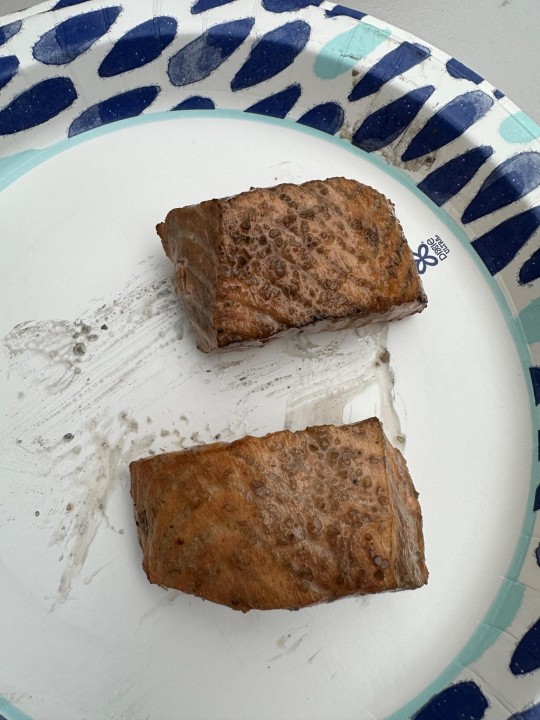
Optional/Notes:
If you use skin on salmon, make sure to check for any leftover scales on the skin and give the skin side a full minute over the fire to get some additional char to it.
If possible, make the salmon nuggets more rectangular than squared and skewer them along the longer side to give more stability when cooking.
#anime food#anime#camping food#food#camping#nos anime#laid back camp#anime foodies#yuru camp#yurucamp#laid back camp the movie
3 notes
·
View notes
Text
Campsite Taco Bar (Makes 6 Servings)

We bring you this recipe from our panel, “Anime Foodies: Laid-Back Camp The Movie”.
As the movie opens, our characters are enjoying a group camping trip during their high school years on a lake shore near Mt. Fuji. For their supper, they create a taco bar that allows everyone to customize the final product to their tastes. While some components of the taco bar are familiar, the centerpiece – a whole chicken roasted in a Dutch oven over coals – is a showcase for their camping adventure.
Roasted Chicken:

1 Whole 5-6 Pound – Chicken
1 4 oz. Stick – Unsalted Butter
1 ½ TSP – Kosher Salt
1 TSP – Black Pepper
1 ½ TSP – Juniper Berries
4 Springs – Rosemary
1 – Orange
2 Small – Russet Potatoes
3 Medium – Carrots
Allow the butter to come to room temperature, mix in the salt and pepper, and set aside.
Cut 4 large slices off the orange and eat the rest.
Roll a large length of heavy-duty aluminum foil into a ring and place it into the bottom of your Dutch oven.
Line the base of the Dutch oven above the foil ring with two layers of heavy-duty aluminum foil and line the lid with another layer of foil.
Remove your chicken from its packaging and dry it off with some paper towels.
Working from the back of the bird, carefully reach in and separate the chicken skin from the meat without tearing it across as much of the bird as possible.
Once the skin is lose, take ½ of the seasoned butter and stuff it into the space you’ve made between the meat and skin of the chicken, spreading it evenly.
Stuff the cavity of the chicken with two slices of orange, 2 springs of rosemary, and ½ TSP of juniper berries and then truss the bird.
Peel the carrots, scrub the potatoes, chop them both into large chunks, and place the few of the smallest of your carrot pieces down in the middle of the Dutch oven.
Take some of the additional butter and smear it over the outside skin of the bird before tucking in the wings and setting it into the middle of the Dutch oven on top of the small portions of carrots.
Spread the remaining root vegetables along the outside of the chicken and dollop the additional butter over these.
Place the other two slices of orange, 2 springs of rosemary, and the remaining TSP of juniper berries over the top of the chicken and then place the lid of the Dutch oven on (making sure it fits tightly to prevent any ash getting in).
Prepare your coals and set 1/3 of them evenly underneath the Dutch oven and the other 2/3 evenly across the lid.
Allow to cook for 1 hour and 30 minutes and then carefully remove the lid, set it aside, and check the temperature with a thermometer (allow to cook for additional 10 minute intervals as required).
Once ready, place a piece of foil loosely over the chicken and allow to rest for 15 minutes before slicing or pulling for tacos as desired.

Optional/Notes:
If you’re not up to roasting an entire chicken with potatoes and carrots for your taco bar, feel free to pick up a rotisserie chicken from your favorite grocery store as a much simpler alternative.
If you have a small cooking rack or something else to keep the chicken from sitting right on the bottom of the Dutch oven, that will also work in lieu of the foil ring. This and the thinner pieces of carrot being under the bird is meant to mitigate the bottom of the chicken from burning while the rest of it roasts.
The juniper, orange, and rosemary mostly function to scent rather than flavor the chicken and can be omitted, if necessary.
When separating the chicken skin from the meat and adding the butter under the skin, emphasize the breast portion of the bird as this portion is most at risk of drying out during the cooking process.
No need to be fancy with your trussing. As long as it keeps the legs together and the back cavity of the bird closed, it will be fine.
For our coals, we were unable to get binchotan like they used in the show. We instead used a similar looking hardwood charcoal we found locally: Blue Hog – Hog Logs. We used 18 in total with 6 on the bottom of the Dutch oven and 12 on the top. These did not require a change, but if you’ll be using smaller lump charcoal or briquettes, check about halfway through the cooking process as additional coals need to be added.
Taco Meat:
1 ¼ Pound – Lean Ground Beef (Ground Turkey)
1 TBSP – Worcestershire Sauce
1 TBSP – Ketchup
½ TBSP – Sake
½ TBSP – Mirin
2 TSP – Chili Powder
½ TSP – Paprika
½ TSP – Garlic Powder
Heat a pan over medium heat and add the ground beef.
Brown the ground beef while breaking up any large chunks.
Add the remaining ingredients, stir to combine everything, and raise the heat to medium high.
Cook, stirring as necessary, until the liquid has almost entirely boiled away.
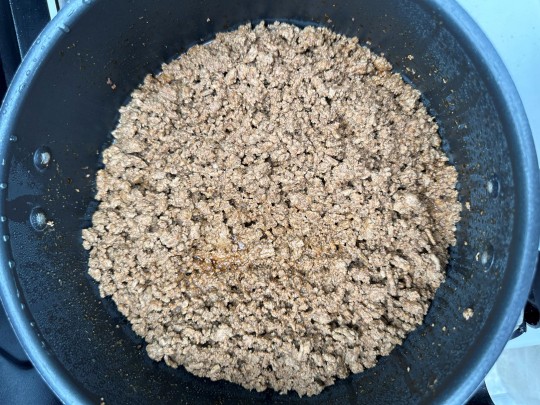
Optional/Notes:
Lean ground beef (93/7) is done to mitigate the need to drain any fat from the pan. You can use fattier ground beef, but you may need to add an additional step of draining the fat.
Ground turkey can also function as a good substitute and typically does not require fat to be drained.
A classic stateside taco seasoning mix can be used in place of the Japanese version presented here if desired.
Taco Shrimp:
1 ¼ Pound Medium, Peeled – Shrimp
1 TBSP – Worcestershire Sauce
1 TBSP – Ketchup
½ TBSP – Sake
½ TBSP – Mirin
1 TSP – Chili Powder
½ TSP – Paprika
½ TSP – Garlic Powder
Take all the ingredients, mix them together, and allow the shrimp to marinate for 30 minutes to an hour in the cooler.
When ready to cook, heat a pan over medium heat and add the shrimp with its marinade.
Cook for 4-6 minutes or until the shrimp are cooked through.

Salsa:
2 Medium – Red Tomatoes
½ – Green Bell Pepper (Any Mild Green Pepper)
¼ Medium – White Onion
1 – Lime
2 Pinches – Kosher Salt
Dice the tomatoes, green pepper, and onions and add them to a serving bowl.
Add the juice of the lime and the salt and stir.

Remaining Taco Bar Ingredients:
1 Head – Red Leaf Lettuce (Romaine Lettuce)
2 – Lime
2 Medium – Red Tomatoes
½ Medium – White Onion
8 oz. Block – Jack Cheese
1 – Avocado
2 Packs, Taco-Size – Flour Tortillas
1 Small Bottle – Tabasco Sauce (Any Preferred Hot Sauce)
Wash your lettuce, separate the leaves, and set aside.
Slice the limes into wedges, the onion into thin half-moons, and the tomatoes into slightly thicker half-moons.
Shred your block of cheese and keep it in the cooler until ready to serve.
Just prior to serving, split and pit the avocado, scoop the flesh out of each half in one piece, and slice into half-moons.
Heat a pan over medium heat and toast the tortillas one at a time for 30 seconds to a minute on each side.
As the tortillas finish, place them on a plate under a towel to keep warm until it is time to serve.

Optional/Notes:
Any long leaf lettuce will work fine.
You can skip the process of shredding your own cheese by buying a standard pack of pre-shredded cheese that you enjoy with tacos.
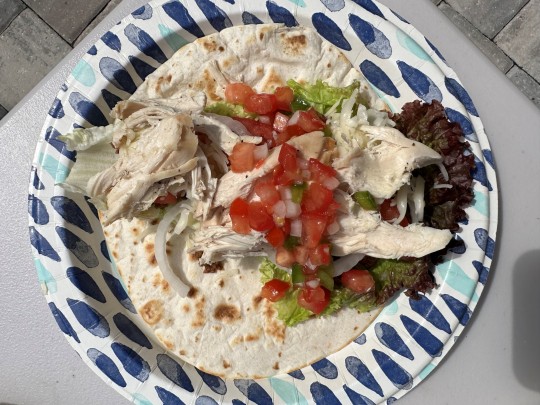
#anime#anime food#nos anime#anime foodies#camping#camping food#food#laid back camp#yuru camp#yurucamp#laid back camp the movie
2 notes
·
View notes
Text
Anime Foodies: Laid-Back Camp The Movie – Recipe Equipment List

This post relates to our panel, “Anime Foodies: Laid-Back Camp The Movie”.
This post is intended to supplement the recipe write-ups and provide simple, yet exact lists of what equipment will be needed to create the camping recipes present in “Laid-Back Camp The Movie” and “Laid-Back Camp Season 2” as depicted in the panel. Each recipe is listed below followed by the equipment needed.
Campsite Taco Bar:
For the Roasted Chicken –
-Small Bowl
-Knife
-Cutting Board
-Measuring Spoons
-Cast Iron Dutch Oven
-Aluminum Foil
-Hook for Dutch Oven Lid
-Plates/Bowl (For Setting Out Bar Ingredients)
For the Taco Meat –
-Measuring Spoons
-10 Inch Skillet
-Wooden Spoon (Some Manner of Stirring Utensil)
-Plates/Bowl (For Setting Out Bar Ingredients)
For the Taco Shrimp –
-Measuring Spoons
-Bowl (For Marinating)
-10 Inch Skillet
-Wooden Spoon (Some Manner of Stirring Utensil)
-Plates/Bowl (For Setting Out Bar Ingredients)
For the Salsa –
-Knife
-Cutting Board
-Bowl (For Setting Out Bar Ingredients)
For the Remaining Taco Bar Ingredients –
-Knife
-Cutting Board
-Cheese Grater
-10 Inch Skillet
-Small Kitchen Towel
-Plates/Bowls (For Setting Out Bar Ingredients)
Aburi Salmon:
-Knife
-Cutting Board
-Long Skewers (Wooden or Metal, Flat Preferred)
Salmon Soup:
-Dutch Oven with Lid
-Knife
-Cutting Board
-Vegetable Peeler
-Wooden Spoon (Some Manner of Stirring Utensil)
-Measuring Spoons
-Measuring Cups
-Bowls (For Serving)
Ishikari Nabe with Yuba:
-Mixing Bowl
-Rolling Pin
-Flat Storage Container (For Storing Houtou)
-Storage Container (For Rehydrating Tofu Skin)
-Vegetable Peeler
-Cutting Board
-Knife
-Wooden Spoon (Some Manner of Stirring Utensil)
-Ladle
-Measuring Spoons
-Measuring Cups
-Dutch Oven/Donabe with Lid
-Bowls (For Serving)
Hot Buttered Rum Cow:
-Small Saucepan
-Knife
-Mugs (For Serving)
Kiritanpo Nabe:
For the Chicken Meatballs –
-Mixing Bowl
-Measuring Spoons
-Flat Storage Container (For Storing Meatballs)
For the Kiritanpo –
-Small Saucepan
-Strainer
-Mixing Bowl
-Bowl
-Mortar
-Pestle
-Wooden Skewers/Cake Dowels/Disposable Chopsticks
-10-Inch Skillet
-Tongs
For the Final Hotpot –
-Dutch Oven/Donabe
-Knife
-Cutting Board
-Tongs
-Serving Spoon
-Bowls (For Serving)
Motsunabe:
-Knife
-Cutting Board
-Dutch Oven/Large Saucepan
-Strainer
-Dutch Oven/Donabe
-Large Saucepan
-Bowls (For Serving)
Wakasagi Tempura:
-Mixing Bowl
-Small Saucepan
-Plate
-Knife
-Cutting Board
-Whisk/Chopsticks
-Tongs
-Measuring Cups
Vegetables Roasted in Foil:
-Heavy Duty Aluminum Foil
-Newspaper
-Tongs
-Heat-Resistant Gloves
#anime#anime food#anime foodies#nos anime#camping#camping food#food#laid back camp#yuru camp#yurucamp#laid back camp the movie
2 notes
·
View notes
Text
Bibliography - "Anime Foodies: Laid-Back Camp Season 2"

This is the bibliography for our newest entry in the Anime Foodies series of panels, “Anime Foodies: Laid-Back Camp Season 2”. The sources include not only places from which we garnered background of the food we were cooking, but also sources that helped us determine how to craft our own version of the recipes we were creating.
This is the first Anime Foodies panel which has a formal bibliography of sources. Those marked with double asterisks are regular sources we’ve used in all of the panels in the series and are a good starting point for anyone interested in Japanese food and its history.
Bibliography:
“10 Surprising Differences Between Japanese-Italian Food and Real Italian Food” Savor Japan, https://savorjapan.com/contents/discover-oishii-japan/10-surprising-differences-between-japanese-italian-food-and-real-italian-food/.
“A Guide to Japanese New Year's Soba” Savor Japan, https://savorjapan.com/contents/discover-oishii-japan/a-guide-to-japanese-new-year-s-soba/.
“Acqua Pazza” Italian Food Forever, https://web.archive.org/web/20210616201441/https://www.italianfoodforever.com/2019/03/acqua-pazza/.
Afro. Laid-Back Camp. Vol. 5, Yen Press, 2019.
Afro. Laid-Back Camp. Vol. 6, Yen Press, 2019.
Afro. Laid-Back Camp. Vol. 7, Yen Press, 2019.
Afro. Laid-Back Camp. Vol. 8, Yen Press, 2020.
Afro. Laid-Back Camp. Vol. 9, Yen Press, 2020.
“Alaska pollock Japanese Pacific coast” Fishsource, https://www.fishsource.org/fishery_page/1906.
“ama divers” Robert Gilhooly, https://robgilhooly.photoshelter.com/image/I0000l0zOUEGWPXs.
“Authentic Japanese Cooking: Beef-wrapped Onigiri” NHK World – Japan, https://www3.nhk.or.jp/nhkworld/en/tv/dining/20200508/2019262/.
“Caprese Salad captures Italy’s rich history” The Sun, https://www.lowellsun.com/2015/08/26/caprese-salad-captures-italys-rich-history/.
Claudia. “How to Make the Fluffy Japanese Pancakes?” Voyapon, 9 Apr. 2021, https://voyapon.com/fluffy-japanese-pancakes/.
“Coastal Area 12802 Izu Peninsula coast” Ecologically of Biologically Significant Marine Areas Identified by Japan, Ministry of the Environment, Government of Japan, https://www.env.go.jp/en/nature/biodic/kaiyo-hozen/kaiiki/engan/12802.html.
Counihan, Carole. Around the Tuscan Table: Food, Family, and Gender in Twentieth Century Florence. New York, Routledge, 2004.
“Fluffy Japanese Pancakes (A.K.A. Souffle Pancakes)” Chocolates and Chai, https://www.chocolatesandchai.com/fluffy-japanese-pancakes-souffle-pancake-recipe.
“Gambas Al Ajillo (Garlic Shrimp)” No Recipes, https://norecipes.com/gambas-al-ajillo-garlic-shrimp-recipe/.
“Gambas al Ajillo, Spain’s Garlic Shrimp Dish” Amigo Foods, https://blog.amigofoods.com/index.php/spanish-foods/gambas-al-ajillo/.
“Gambas Al Ajillo (Spanish Garlic Shrimp)” The Mediterranean Dish, https://www.themediterraneandish.com/gambas-al-ajillo-spanish-shrimp/.
“How to make Japanese dried fish (HIMONO) in your refrigerator.” Jinta Express, https://www.jinta-express.com/entry/dried-fish-in-fridge.
**Ishige, Naomichi. The History and Culture of Japanese Food. London, Kegan Paul Limited, 2001.**
“Japanese Otsumami 101” Tokyo’s Best Cheap Eats, http://tokyogroumet.blogspot.com/2006/12/japanese-otsumami-101.html.
Kirkpatrick, John. “All About Risotto: The History & Fundamentals of a Favorite Italian Dish.” Cuisine at Home, https://www.cuisineathome.com/articles/all-about-risotto/.
Laid-Back Camp. Directed by Yoshiaki Kyougoku. C-Station, 2018.
Laid-Back Camp Season 2. Directed by Yoshiaki Kyougoku. C-Station, 2021.
Lalli Music, Carla. “BA’s Best Risotto” Bon Appétit, 29 Mar. 2019, https://www.bonappetit.com/recipe/bas-best-risotto.
“Lobster Himono” Taste of Homes Throughout Japan: Story of Local Japanese Cuisine, http://kyoudo-ryouri.com/en/food/2998.html.
McWilliam, Paulette S. “Evolution in the Phyllosoma and Puerulus Phases of the Spiny Lobster Genus Panulirus White.” Journal of Crustacean Biology, vol. 15, no. 3, 1995, pp. 542–57. JSTOR, https://doi.org/10.2307/1548775.
Nagata, Kelly. “Otsumami: choose the right food to go with your drink” Voyapon, 22 Feb. 2016, https://voyapon.com/otsumami-food-drink/.
“Nikumaki Onigiri Meat Wrapped Rice Balls” Japan Centre, https://web.archive.org/web/20210411195317/https://www.japancentre.com/en/recipes/269-nikumaki-onigiri-meat-wrapped-rice-balls.
“Nikumaki Onigiri Recipe” Japanese Cooking 101, https://www.japanesecooking101.com/nikumaki-onigiri-recipe/.
“Nikumaki Onigiri Recipe (Japanese Meat Wrapped Rice Balls)” My Japanese Recipes, https://myjapaneserecipes.com/nikumaki-onigiri-recipe-japanese-meat-wrapped-rice-balls/.
“Pesce all’ Acqua Pazza” Anna Maria Volpi A Passion for Cooking, https://archive.ph/20081224132934/http://www.annamariavolpi.com/acqua_pazza.html#selection-769.0-769.22.
Plunkett-Hogge, Kay. “The history and origins of the Spanish tapas” The Telegraph, 1 Jul. 2016, https://web.archive.org/web/20181104010149/https://www.telegraph.co.uk/food-and-drink/tapas-and-beer/history-of-tapas/.
Ptacek Margaret B. , Sarver Shane K. , Childress Michael J. Herrnkind William F. “Molecular phylogeny of the spiny lobster genus Panulirus (Decapoda: Palinuridae).” Marine and Freshwater Research, vol. 52, 2001, pp. 1037-1047. ResearhGate, https://doi.org/10.1071/MF01070.
“Salmon in Foil (Video) 鮭のホイル焼き” Just One Cookbook, https://www.justonecookbook.com/salmon-foil/.
“Shrimp and Tomato Risotto” Food Network, https://www.foodnetwork.com/recipes/shrimp-and-tomato-risotto-recipe-1953281.
“Simmered Alfonsino” Taste of Homes Throughout Japan: Story of Local Japanese Cuisine, http://kyoudo-ryouri.com/en/food/2440.html.
**Singleton Hachisu, Nancy. Japanese Farm Food. Kansas City, Andrews McMeel Publishing, 2012.**
**Singleton Hachisu, Nancy. Preserving the Japanese Way. Kansas City, Andrews McMeel Publishing, 2015.**
“Spaghetti all’Acqua Pazza (Spaghetti with Fish and Tomatoes)” Stefan’s Gourmet Blog, https://stefangourmet.com/2014/04/26/spaghetti-allacqua-pazza-spaghetti-with-fish-and-tomatoes/.
“Tapas, the Little Dishes of Spain” Living Language, https://web.archive.org/web/20180503042918/https://www.livinglanguage.com/blog/2012/03/20/tapas-the-little-dishes-of-spain/.
The Ministry of Agriculture, Forestry and Fisheries. Fisheries of Japan—FY2010. https://www.jfa.maff.go.jp/j/kikaku/wpaper/pdf/2010_haku_en6.pdf.
“Tomato and Shrimp Risotto” Broma, https://bromabakery.com/tomato-shrimp-risotto-recipe/.
“Tomato and Shrimp Risotto” Pescatarian Kitchen Food Blog, https://pescetarian.kitchen/tomato-prawn-risotto/.
“Toshikoshi Soba (New Year’s Eve Soba Noodle Soup) 年越しそば” Just One Cookbook, https://www.justonecookbook.com/toshikoshi-soba/.
“Toshikoshi Soba: Why do Japanese Slurp Noodles on New Year's Eve?” Live Japan, https://livejapan.com/en/article-a0000814/.
“Toshikoshi Soba (年越しそば)” Food in Japan, https://www.foodinjapan.org/japan/toshikoshi-soba/#index_id3.
Trowbridge Filippone, Peggy. “Emeril's Homemade Lobster Sauce” The Spruce Eats, 26 Oct. 2020, https://web.archive.org/web/20210212010546/https://www.thespruceeats.com/lobster-sauce-recipe-1808932.
Wei, Clarissa. “Why We Don’t Eat California Spiny Lobsters (Even Though They Taste Better).” Vice, 12 Oct. 2016, https://www.vice.com/en/article/gvk5kq/why-we-dont-eat-california-spiny-lobsters-even-though-they-taste-better.
White, Corky. “Italian Food: Japan's Unlikely Culinary Passion” The Atlantic, 6 Oct. 2010, https://www.theatlantic.com/health/archive/2010/10/italian-food-japans-unlikely-culinary-passion/64114/.
Wickers, Kate. “Insalata Caprese” Italy Magazine, 10 Aug. 2012, https://www.italymagazine.com/featured-story/insalata-caprese.
“ハーブソルトのおすすめ10選。いつもの料理がより本格的に” Sakidori, https://sakidori.co/article/923638.
“ハウス 香りソルト イタリアンハーブミックス 53g” Rakuten, https://product.rakuten.co.jp/product/-/d88e483ed45123cc6b0e15bb10bde333/?scid=af_pc_etc&sc2id=af_117_1_10001720.
#anime#anime food#anime foodies#nos anime#camping#food#yurucamp#yuru camp#laid back camp#laid back camp season 2#camping food#bibliography#anime bibliography
1 note
·
View note
Text
Japanese-Style White Rice (Camping Recipe)
Since it’s so ubiquitous to Japanese cooking, we thought we should provide the recipe for how we prepare Japanese-style, short-grain rice while we’re out camping. The instructions are provided based on preparing 1 cup of dry, short-grain rice, but the “Optional/Notes” section will include some numbers for working with a few other amounts of dry rice that may be common depending on the size of your party.
1 Cup – Japanese Short-Grain Rice
1 Cup + 3 1/2 TBSP – Water
Place the rice into a large mixing bowl and cover with a decent amount of water.
Press the rice down with the palm or back of your hand and stir until the water gets cloudy and then drain the rice.
Add more water and repeat this Steps 1 & 2 until the water does not turn cloudy (or is at least pretty clear).
Take the drained rice and place it into the pot in which you’ll be cooking it and cover with the cooking water.
Allow the rice to sit in the cooking water for 30 minutes (or up to an hour if it’s cold outside).
Place a tight fitting lid on the pot and place over high heat.
Allow the rice to come to a boil and wait until you see a steady stream of steam forcing its way out from the lid.
Turn off the heat, leave the rice covered, and allow to sit for 7 minutes.
Turn the heat back on high for 10 seconds, turn off again, remove the lid, and it’s ready to serve.
Optional/Notes:
If you’re using 1 1/2 cups rice, use 1 3/4 cups + 1 TBSP water; if you’re using 2 cups rice, use 2 1/4 cups + 3 TBSP water.
Polishing rice as noted in Steps 1-3 will take a substantial amount of extra clean water so, if you’re camping, make sure you have a gallon jug or two of water around if you’ll be making rice.
#anime#anime food#anime foodies#nos anime#camping#food#yuru camp#yurucamp#laid back camp#laid back camp season 2#camping food
14 notes
·
View notes
Text
Hotcake Cake (Makes 4 Servings)

We bring you this recipe from our panel, “Anime Foodies: Laid-Back Camp Season 2”.
This layer cake made out of Japanese-style hotcakes serves as the dessert for Aoi and Nadeshiko’s birthday celebration on the second evening of the Izu camping trip in Episode 12. While it serves as a brilliant solution to making a cake without an oven, the need to whip eggs and cream by hand do make this probably the most physically taxing of any “Laid-Back Camp” recipe to date.
6 – Eggs
12 TBSP – Sugar
6 TBSP – Whole Milk
1 1/2 TSP – Vanilla Extract
9 TBSP – Cake Flour (AP Flour)
1 1/2 TSP – Baking Powder
2 Cups – Heavy Whipping Cream
1 – Mango
1 – Kiwi
1/3 Cup – Round Grapes
1 Cup – Strawberries
2 In. x 1 In. Square – Milk Chocolate [Optional]
1 Pack – Cookie Frosting [Optional]
Separate your eggs with the 6 egg whites being set aside for the meringue, 3 yolks being set aside for the yolk mixture, and the other 3 yolks stored in the fridge/cooler for use in another recipe.
Mix the 3 egg yolks and 6 TBSP of sugar until combined and frothy.
Add the milk and vanilla extract and stir together.
Add the flour and baking powder together, stir, and incorporate into the yolk mixture until there are no visible lumps while trying to stir as little as possible.
In as large and as wide of a bowl as is available, whip the egg whites with a whisk until frothy and then add 4 TBSP of sugar in batches until a meringue is formed with medium peaks.
Take roughly 1/3 of the meringue and mix into the yolk mixture to lighten it.
Fold the remaining meringue into the yolk mixture in two or three batches being careful not to knock out too much air.
Heat an 8 or 10-inch non-stick pan over low heat, spray with some oil, and add 3/4 cup of the hotcake batter in an even layer.
Cover and cook for 3 minutes.
Remove the lid, add another 1/2 cup of batter evenly across the top of the already cooking hotcake, cover, and cook for another 4-5 minutes.
To flip the hotcake, slide it out of the pan, cooked side down onto a large paper plate, put the pan over the top, and quickly upend the plate back down into the pan.
Use your spatula to fix any uneven edges from the flip and then cover and cook for another 4-5 minutes.
Once finished, remove the hotcake and set on a plate under a damp paper towel.
Repeat Steps 8 through 13 to create a second large hotcake.
Again, using the largest and widest bowl you have available, whip the heavy cream until slightly thickened, add the final 2 TBSP of sugar, and continue whipping until you have stiff peaks.
Take your mango and cut both thin slices and larger chunks for the top of the cake.
Skin the kiwi and cut into thin slices.
Slice your largest strawberries for the middle of the cake and leave your smallest ones whole for the topping.
Take your square of chocolate and write whatever you want as a message for the top of the cake with the cookie frosting before setting it in the fridge/cooler until ready to place on the cake. [Optional]
To build the cake, set one of the hotcakes on a plate and top with a layer of the whipped cream and the thin-sliced mango, kiwi, and strawberries while leaving some room on the edge of the whipped cream layer.
Add the second cake and another layer of whipped cream on top.
Add some whipped cream to a small resealable plastic and cut off the corner. Use this bag of cream to pipe a border of whipped cream around the top edge of the cake.
Take some of the remaining thin slices of fruit and alternate them in the edge of the layer of cream between the two hotcakes.
Place the whole grapes, whole strawberries, mango chunks, and kiwi slices inside the thicker whipped cream border on the top of the cake and finish with the chocolate message if made.
Slice carefully with a serrated cake knife to serve or merely consume directly from the plate.

Optional/Notes:
This recipe isn’t as exacting as some of the others, so there is a not insignificant chance that there will be additional hotcake batter and fruit leftover. Use any extra batter immediately and store the additional hotcakes in the cooler.
We used the exact fruits the girls used for the sake of the panel, but feel free to use a mix of whatever fruits are in season.
If you’ll be doing the chocolate plaque, a basic chocolate bar from the grocery store is a great way to get a flat chocolate surface to work with.
The additional egg yolks will last for 2-3 days in the fridge.
For whipping the egg whites and the cream, hand power will be the default method when outside, but you can find battery-powered/crank hand mixers which can significantly lighten the workload.
When building the cake, make sure to use whatever of your two cakes is the most perfect and stable for the base to diminish the chances of the cake falling over.
Feel free to use a real piping bag, but the plastic bag method will definitely reduce the need for cleaning.
#anime#anime food#anime foodies#nos anime#camping#food#yuru camp#yurucamp#laid back camp season 2#camping food
19 notes
·
View notes
Text
Shrimp and Tomato Risotto with Lobster Sauce (Makes 6 Servings)
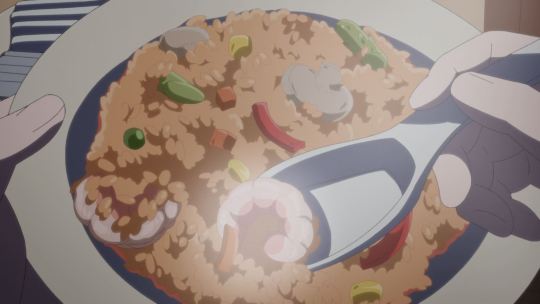
We bring you this recipe from our panel, “Anime Foodies: Laid-Back Camp Season 2”.
This rich risotto with a creamy seafood sauce serves as the main course for Aoi and Nadeshiko’s birthday celebration on the second evening of the Izu camping trip in Episode 12. Like recipes from the first season, this one takes some ingredients from the previous night’s meal and uses it as a key component of this dish. This is, by far, the largest and heartiest single recipe made in the show’s food-filled second season.
2 Whole –Spiny Lobster Shells (Maine Lobster Shells)
10 Cups + Additional – Water
1 TBSP + 1 TSP – Kosher Salt
10 TBSP – Extra Virgin Olive Oil
1/2– Large White Onion
2 Cups – Arborio Rice (Japanese Short-Grain Rice)
1 Cup – Dry White Wine
10 1/2 TBSP – Unsalted Butter
1 3/4 Cup Grated – Parmesan Cheese
3 1/2 TBSP – Tomato Paste
1 Lbs. – Medium Shell-On Shrimp
1 8 Oz. Can – Peas and Carrots
1 8 Oz. Can – Corn
1/2 Bunch – Asparagus
1 Cup – Sliced White Button Mushrooms
1/4 – Red Bell Pepper
1/4 – Orange Bell Pepper
1 1/2 TBSP – Flour
1/4 Cup – Heavy Cream
Break the lobster shells into chunks and add to 10 cups of water in a large stock pot along with 1 TBSP of kosher salt.
Bring to a boil, reduce to a simmer, cover, and cook for 45 minutes.
Once the time is up, strain the stock and, if preparing at home, store in food safe containers for transport to the campsite or use immediately.
Finely dice the white onion and, if preparing at home store in a food safe container for transport to the site or use immediately.
Separate the shrimp from their shells and have them both available for use later in the recipe.
Drain the peas, carrots, and corn, chop the asparagus into 1/2 inch pieces, and combine all of these ingredients into a bowl for use later in the recipe.
Slice the red and orange bell pepper pieces into short matchsticks and set aside for use later in the recipe.
In a large saucepan, heat 8 cups of the lobster stock to a simmer and reduce the heat to keep it close to or at a bare simmer.
In a separate large cooking pot over medium heat, add 6 TBSP of extra virgin olive oil, the diced onions, and a pinch of salt and cook for 10-12 minutes.
Add the dry rice to the pot and continue to cook for 4-5 minutes, stirring constantly, until the grains are uniformly translucent around the edges.
Once the rice is at this stage, add another pinch of salt and the white wine to the pot and cook, stirring constantly, about 2-3 minutes or until the wine has been entirely absorbed.
From here, take a ladle’s worth of the lobster stock from the saucepan and add it to the cooking risotto, stirring constantly, until the liquid has very nearly been absorbed. This should take 2-3 minutes and, if this is happening faster than this, reduce the heat slightly.
Repeat this process, adding ladles of the broth as needed, for 25 minutes and then test the rice for doneness. The rice should be al dente – slightly firm, no crunch and with no chalky residue.
Add more ladles of broth as needed and, if necessary, use the additional 2 cups of prepared broth.
Once the rice is al dente, turn off the heat and add 5 TBSP of butter in small pieces and stir until melted into the risotto.
Then, in batches, add 1 1/4 cups of the grated parmesan until it is entirely incorporated into the risotto.
Cover the pot with a lid, set it on a large towel, and wrap it up in order to keep it insulated while the further cooking is completed.
In a small saucepan over high heat, take 2 cups of lobster broth – adding extra water if some of it was used for the risotto – and add in the shrimp shells.
Bring to a boil, reduce to a simmer, and cook uncovered for 10 minutes.
Once the time is up, strain out the shrimp shells and make sure that you still have 1 1/2 cups of liquid remaining (add additional water if necessary)
Dry but do not clean the saucepan and, over medium heat, add 1 1/2 TBSP of butter, melt, and then add 1 1/2 TBSP of flour and 1/2 TBSP of tomato paste.
Cook, stirring frequently, for 2-3 minutes, add the lobster stock back in, and bring to a simmer for 5 minutes.
Add 1/4 cup of heavy cream, bring to back to a simmer, and reduce the heat to keep at a low simmer for 10-15 minutes or until the sauce is reduced by about half and is thickened.
Cover and set aside to be reheated as necessary when the risotto is finished.
In a large sauté pan over medium heat, add 4 TBSP of butter and 4 TBSP of olive oil.
Add 3 TBSP of tomato paste and cook for 1-2 minutes or until the tomato paste has begun to color the oil red.
Add the peas, carrots, corn, asparagus, mushrooms, and two pinches of salt and sauté for 5 minutes or until the mushrooms have begun to wilt from cooking a bit.
Add the deshelled shrimp and cook for 3-5 minutes or until they are very nearly cooked.
Add the bell peppers and cook for two more minutes to warm them through.
Turn off the heat, uncover the risotto pot, and add all the contents of the sauté pan into the risotto and mix thoroughly until the mix is entirely incorporated and no streaks of white remain in the risotto.
Serve on plates or bowls with the 1/2 cup of grated parmesan and the seafood cream sauce to be added on top as desired.
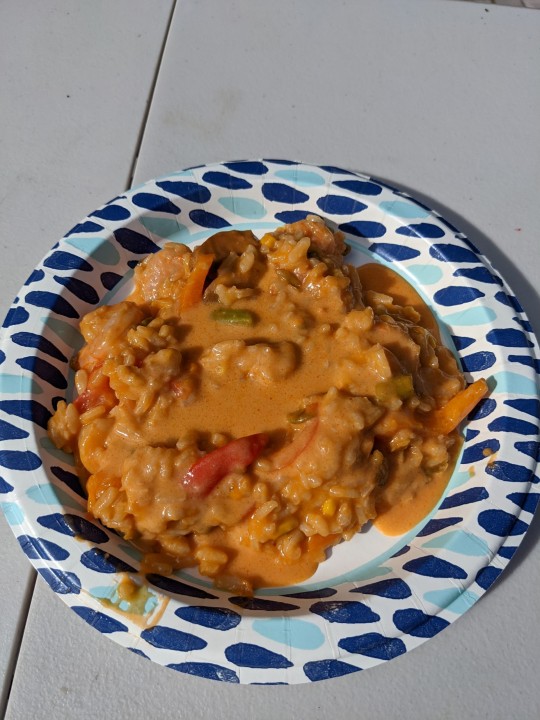
Optional/Notes:
This recipe is based around having a standard outdoor kitchen stove with only two burners available at any one time. If you’re working at home without these limitations, feel free to work things side-by-side, but make sure you don’t fail to stir the risotto appropriately as it’s cooking.
If you don’t happen to have lobster in particular, any shellfish will work to make the stock in terms of getting the intended flavor. Fish will make a fine substitute if you want a seafood flavor, but will be quite different than shellfish.
If you’ll be bringing the pre-made stock with you to the campsite, for our preferred delivery method – 32 oz. Ball jars – you’ll end up needing 3 of them to bring all the necessary stock.
Tomato paste in those metal tubes are clutch at all times and especially so if you’ll be cooking outdoors.
If you’ll be making this at home, you can just tuck the pot into a warm oven instead of worrying with a towel.
If you don’t want the bell peppers to be so crunchy, add in with the shrimp and just cook until the shrimp is cooked through.
If you feel anything – the risotto or the cream sauce – are not red enough, a touch of paprika will bring in a lot of that deep red color with minimal additional flavor.
#anime#anime food#anime foodies#nos anime#camping#food#yuru camp#yurucamp#laid back camp season 2#camping food
18 notes
·
View notes
Text
Otsumami Set (Makes 4 Servings)
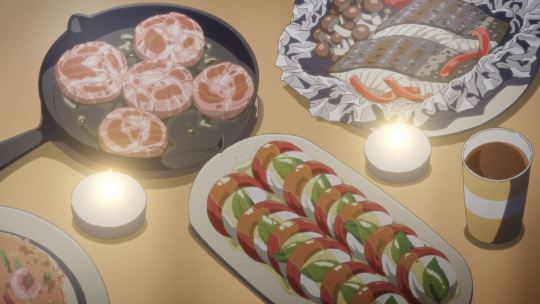
We bring you this recipe from our panel, “Anime Foodies: Laid-Back Camp Season 2”.
As part of the birthday celebrations for Nadeshiko and Aoi in Episode 12, the other girls prepare a set of three “otsumami” along with the other dishes that are designed to pair well with alcohol as a kind gesture to their booze-loving teacher, Ms. Toba.
Caprese Salad
2 Large – Red Tomatoes
2 Balls (8 oz.-Size) – Mozzarella
Handful – Basil
1 TBSP – Extra Virgin Olive Oil
2 Pinches – Black Pepper
Slice the tomatoes and mozzarella into 1 cm (c. 1/3 inch) thick slices.
Arrange in rows with tomato, mozzarella, and then 1 large/2 small basil leaves and repeat the process until you are out of ingredients.
Drizzle the extra virgin olive oil evenly across the rows of ingredients.
Sprinkle over the black pepper and serve.
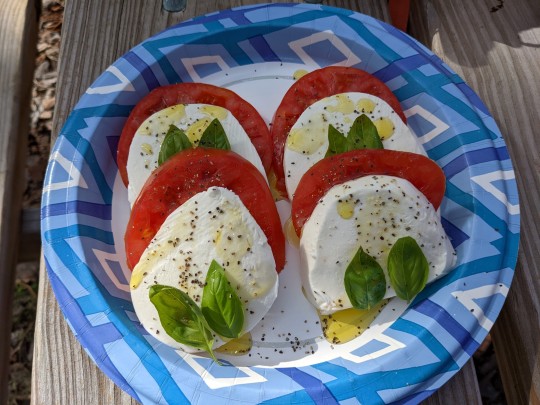
White Fish in Foil Packet
2 Thick-Cut, Skin-On Fillets – Whitefish Such as Halibut or Sea Bass (Haddock, Cod)
3 oz. – Shimeji Mushrooms
8-10 – Cherry Tomatoes (Grape Tomatoes)
1/2 – Red Bell Pepper
1/4 – Small White/Yellow Onion
1/2 TSP – Kosher Salt
1/2 TSP – Black Pepper
Check your fillets for any leftover bones or scales.
Prepare a foil packet with double-layered heavy duty aluminum foil.
Spray the foil with cooking spray and lay the fillets skin-side down in the center of the packet.
Season the fillets with some of the salt and pepper.
Slice the red pepper and onions into thin strips.
Separate the mushrooms and chop off any dirty bases.
Place the mushrooms and tomatoes in sections of the packet and spread the sliced peppers and onions across the other ingredients.
Season with the remaining salt and pepper and seal the packet.
Place the packet in a skillet over medium-high heat for 2 minutes.
Reduce the heat to medium and cook for 10-12 minutes depending on the thickness of your fillets.
Remove from the heat and let sit for 2 minutes.
Open the packet and serve.
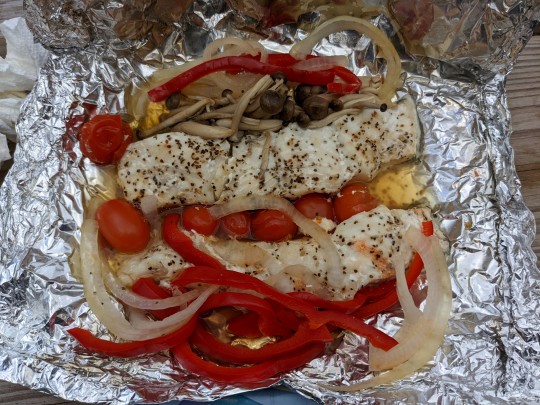
Bacon-Wrapped Onigiri
1 Cup (Dried) – Japanese Short Grain White Rice
2 TSP – Toasted Sesame Seeds
1 TSP – Kosher Salt
15 Slices – Thin-Cut Bacon
Prepare the rice per the instructions provided here.
Place the rice in a mixing bowl and mix in the sesame seeds and salt.
Allow the rice to cool for 5 minutes and then form into 5 small discs.
Allow the discs to set for 5 minutes.
Set three strips of bacon down with the pieces crossing each other in the middle to make the shape of an asterisk.
Set the rice disc into the center of the bacon slices where they meet.
Wrap each piece of bacon around the disc one at a time, trimming any excess lengths of bacon as necessary and spreading the bacon as it is wrapped to ensure the rice is entirely covered by the meat.
Place the wrapped rice discs with the seam side down in a pan over medium heat, cover, and cook for 7 minutes.
Flip to the other side, cover, and cook another 7 minutes.
Uncover and continue to cook on each side if additional crispiness is desired on the bacon.
Remove from the pan, allow to cool for 2 minutes, and serve.

#anime#anime food#anime foodies#nos anime#camping#food#yuru camp#yurucamp#laid back camp season 2#camping food
7 notes
·
View notes
Text
Alfonsino Acqua Pazza Pasta (Makes 4 Servings)

We bring you this recipe from our panel, “Anime Foodies: Laid-Back Camp Season 2”.
The second round of the main course for supper on the first night of the Izu camping trip in Episode 11 takes the leftover seasoned olive oil of the Chunky Ajillo and uses it as the base flavoring agent of this ingredient-loaded pasta finisher. While traditional acqua pazza from Italy tends to be a simpler, lighter dish than what we get here – especially considering the addition of pasta – the ultimate result is delicious.
1 1/3 Cups – Seasoned Extra Virgin Olive Oil from Chunky Ajillo (Extra Virgin Olive Oil seasoned with Garlic and Spices, See “Optional/Notes”)
1/2 Head – Garlic
1 – Fresh/Dried Togarashi Pepper (Fresh/Dried Chile de Arbol)
1/2 Cup – Chinese Eggplant
1/3 Cup – White Button Mushrooms
1/3 Cup – Shimeji Mushrooms (White Button Mushrooms)
1/3 Cup – Octopus Tentacles (Squid Tentacles)
1/3 Cup – Japanese-Style Wieners (Hot Dogs)
1/3 Cup – Medium Shrimp
1/3 Cup – Baby Corn
1/3 Cup – Red Bell Pepper
1/3 Cup – Orange Bell Pepper
1/3 Cup – Chinese Yam
1/3 Cup – Broccoli
2 – Alfonsino Himono (Fresh Alfonsino/Any Small Snapper)
3/4 Cup – Water
1 Cup – Dry/Semi-Dry White Wine
1 Cup – Cherry Tomatoes (Grape Tomatoes)
1/2 Lb. – Linguine
3 TSP – Capers
1/3 Cup – Fresh Basil
1/4 Cup – Sliced Black Olives
1/4 TSP – Kosher Salt
1/2 TSP – Black Pepper
Wash and peel the Chinese yam, cut into bite-sized pieces, parboil for 3 minutes, and drain.
Cut broccoli florets into bite-sized pieces, parboil for 2 minutes, and drain.
Put these together in a zip-top bag to take to the campsite.
Once on-site, get all the garlic cloves out of their paper – halving any particularly large ones – and then chop the eggplant, white button mushrooms, shimeji mushrooms, octopus tentacles, Japanese-style wieners, shrimp, baby corn, red bell pepper, orange bell pepper into bite-sized pieces and cover until needed.
Finely mince 2-3 cloves of garlic and finely chop the chili into rounds.
Remove the heads of your alfonsino himono and set aside for separate grilling or use in stock.
Prepare your grill and coals and coat the fish on the skin side with a bit of high heat oil like canola. You’ll want the coals to be within a few inches of the grates if possible.
Grill the fish for 4-5 minutes or until the flesh has firmed up and the skin is well charred.
Remove the fish, allow cooling, and deboning it in the biggest pieces you can manage.
Bring a pot of unsalted water to a boil over high heat and cook the linguine according to package directions (c. 10 minutes).
Drain the pasta and cover until needed.
Place your pot over medium-low heat and add the oil from the Chunky Ajillo.
Once heated, add the vegetables and cook for 10-15 minutes or until a fork passes easily through the pieces of eggplant.
Add the deboned alfonsino, water, white wine, and cherry tomatoes, raise the heat to high, and boil for 3 minutes.
Add the cooked pasta and other meat and cook for 3-5 minutes or until the shrimp has finished cooking through.
Tear or chop the basil into small pieces unless you have particularly small leaves while the final minutes of cooking are completing.
Cut the heat, add the basil, capers, chopped olives, salt, and pepper, stir to warm these ingredients through, and serve.

Optional/Notes:
If you’re not using the oil from the Chunky Ajillo recipe, take 5-7 minced garlic cloves, 2-3 chilies, 2 TSP of Japanese-Style Herb Salt, and 1 TSP of black pepper and heat this in your pot over low heat for 10 minutes or until very the oil is very fragrant prior to Step 13.
If you do not have access to a Japanese-style herb salt, our recipe for one can also be found on our Tumblr page here.
If you’re using fresh fish, add about a 1/4 TSP of salt when you add the fish in Step 14.
The recipe description from the show never specifies verbally when to add the meat beyond the alfonsino himono, so we’ve opted to add it in Step 15 to ensure the seafood isn’t overcooked.
As many camping stoves are not large enough to have two large pots cooking side-by-side at once – or maybe even have a single burner – we opted to have the pasta added a touch earlier than the kids technically do in the show in order to allow the pasta to heat up and soak up some of the cooking liquid. If you have the ability to pull the pasta directly out of some boiling water to add to the dish, you may add it in for 1 minute after the cooking time of Step 15 before moving on to Step 16 and beyond.
#anime#anime food#anime foodies#nos anime#camping#food#yuru camp#yurucamp#laid back camp season 2#camping food
9 notes
·
View notes
Text
Chunky Ajillo (Makes 4 Servings)

We bring you this recipe from our panel, “Anime Foodies: Laid-Back Camp Season 2”.
The main course for supper on the first night of the Izu camping trip in Episode 11 is another example of creating one dish and turning it into something else entirely (which seems to be a bit of a thing for this series if you recall Season 1’s sukiyaki). This hearty dish made by cooking various vegetables and meats in seasoned olive oil is a play on a Spanish dish and, despite the name, can be readily made in a metal pot.
The seasoned oil remaining after eating this dish will be used in the subsequent recipe for Alfonsino Acqua Pazza Pasta, so do not discard this if you’ll be making that dish. If you won’t be, the oil is phenomenal with some crusty bread.
1 1/3 Cups – Extra Virgin Olive Oil
1 1/2 Heads – Garlic
2-3 – Fresh/Dried Togarashi Peppers (Fresh/Dried Chile de Arbol)
2 TSP – Japanese-Style Herb Salt
1/2 Cup – Chinese Eggplant
1/3 Cup – White Button Mushrooms
1/3 Cup – Shimeji Mushrooms (White Button Mushrooms)
1/3 Cup – Octopus Tentacles (Squid Tentacles)
1/3 Cup – Japanese-Style Wieners (Hot Dogs)
1/3 Cup – Medium Shrimp
1/3 Cup – Baby Corn
1/3 Cup – Red Bell Pepper
1/3 Cup – Orange Bell Pepper
1/3 Cup – Chinese Yam
1/3 Cup – Broccoli
1 TSP – Kosher Salt
1 1/2 TSP – Black Pepper
2 TSP – Dried Parsley
Wash and peel the Chinese yam, cut into bite-sized pieces, parboil for 3 minutes, and drain.
Cut broccoli florets into bite-sized pieces, parboil for 2 minutes, and drain.
Put these together in a zip-top bag to take to the campsite.
Once on-site, get all the garlic cloves out of their paper – halving any particularly large ones – and then chop the eggplant, white button mushrooms, shimeji mushrooms, octopus tentacles, Japanese-style wieners, shrimp, baby corn, red bell pepper, orange bell pepper into bite-sized pieces and cover until needed.
Finely mince 5-7 cloves of garlic and finely chop the chilies into rounds.
Place your pot over low heat and add the minced garlic, chilies, and herb salt and cook for 10 minutes or until the oil is very fragrant.
Raise the heat to medium-low, add the eggplant, white button mushrooms, shimeji mushrooms, and the remaining whole garlic cloves, and cook for 10-15 minutes or until a fork passes easily through the pieces of eggplant.
Add the octopus, shrimp, Japanese-style wieners, baby corn, red bell pepper, orange bell pepper, Chinese yam, and broccoli and cook for 4-6 minutes or until the shrimp has finished cooking through.
Once the shrimp is cooked, cut the heat, and add the salt, pepper, and dried parsley.
Eat directly out of the pot or served into individual bowls while making sure you save the leftover oil for the next recipe.
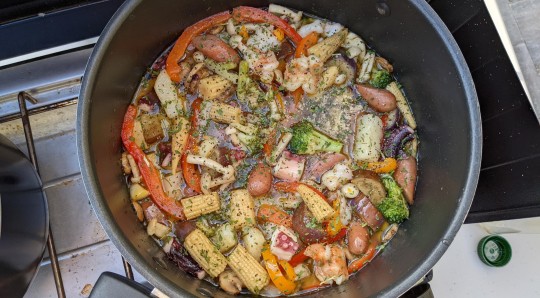
Optional/Notes:
We used a standard Dutch oven which is a little bigger than the donabe the kids used, hence the slightly larger amount of oil than they mention in the show to ensure the ingredients were covered.
If you do not have access to a Japanese-style herb salt, our recipe for one can also be found on our Tumblr page here.
The vegetables/meats are measured in rough cup-sized measures based on what worked for getting a reasonable amount of food in the pan after the different ingredients were chopped. As these ingredients are not conducive to fitting in cups per se, don’t be too picky if you get too much or too little.
For some extra oomph to your oil, feel free to use some extra virgin olive oil instead of one hundred percent plain olive oil.
For more tender octopus, omit from Step 8, cook the other ingredients for 3 minutes, and then add the octopus for 3 minutes to make sure it’s just cooked by the time you’re finished.
If you won’t be saving the oil for something else, some crusty bread to soak it up would not be remiss.
#anime#anime food#anime foodies#nos anime#camping#food#yuru camp#yurucamp#laid back camp season 2#camping food
5 notes
·
View notes
Text
Grilled Alfonsino Himono Heads (Makes 2 Servings)

We bring you this recipe from our panel, “Anime Foodies: Laid-Back Camp Season 2”.
After using the majority of the alfonsino himono for the acqua pazza on the first night of the Izu camping trip in Episode 11, Nadeshiko takes the leftover heads and grills them over coals on Rin’s portable grill. While the characters eat the grilled heads bones and all, picking over them to enjoy the bits of grilled meat and skin is perfectly acceptable.
2 – Salt-Dried Alfonsino Heads (Fresh Alfonsino Heads/Fresh or Salt-Dried Heads of Any Small Snapper Variety)
Prepare your grill and coals and coat the fish heads on the skin side with a bit of high heat oil like canola. You’ll want the coals to be within a few inches of the grates if possible.
Place the fish heads skin side down over the coals and cook for 3-4 minutes or until well charred.
Add a bit more high-heat oil to the flesh side of the heads and flip.
Cook for 2-4 minutes depending on your desired level of char.

Optional/Notes:
If you’re using fresh fish as a substitute, sprinkle some salt on each side prior to grilling.
If you’re using another variety of himono as a substitute, no additional salt is required as the fish is essentially pre-seasoned.
#camping food#anime food#anime foodies#anime#nos anime#camping#food#yuru camp#yurucamp#laid back camp season 2
5 notes
·
View notes
Text
Grilled Lobster Himono (Makes 4 Servings)
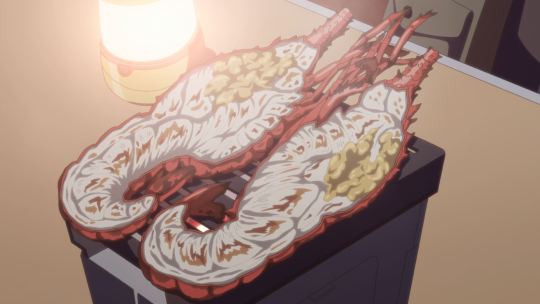
We bring you this recipe from our panel, “Anime Foodies: Laid-Back Camp Season 2”.
This dried lobster is a special treat that the kids grill up for their first night of camping on the Izu peninsula in Episode 11. Himono lobster is a special and expensive ingredient found in certain parts of coastal Japan with the communities around the Izu Peninsula being well known for it. As there is no publicly available recipe we could find for this, we tried a few different methods for making himono lobster and the following recipe was the one that tasted best.
2 Whole –Spiny Lobsters
9 TSP – Kosher Salt
12 Cups – Water
While at home, mix the salt and water, stir until the salt is fully dissolved, and place into a large food-safe container.
If your lobsters are live, place in the refrigerator for 1 hour before using your preferred method to dispatch them.
Take the lobsters and split them in half down the middle using a heavy knife or heavy duty kitchen shears.
Clear out any clearly visible shell fragments generated in the previous step and then gently submerge the lobster halves into the salt water.
Allow to sit in the salt water for 30 minutes.
After the soaking time is up, remove the lobster halves and drain any excess water, but do not worry about getting it perfectly dry.
Place the lobster halves shell-side down on a rack in the refrigerator, uncovered, for 24 hours.
If the lobster will not be used that day, wrap in aluminum foil and freeze.
For cooking, remove the lobster – previously thawed if necessary – from the fridge and then prepare your grill with whatever coals you’ll be cooking over.
When the coals are ready, spread a small amount of a high heat, neutral cooking oil onto the skin side of the lobster halves and lay them skin side down on the grill for 3 minutes.
Flip the lobster halves to their shell side and cook for 4-5 minutes, remove from the heat, and serve.

Optional/Notes:
For the spiny lobster, you’ll really find two varieties available most commonly stateside: California Spiny Lobster on the West Coast and Caribbean Spiny Lobster on the East Coast. Both varieties are basically the same in taste and either might also be labeled “rock lobster”, so keep an eye out for that.
Kosher salt is being used because the goal of the recipe is to create a 3% brine for the lobster. If you use another kind of salt, you’ll want to measure things by weight to ensure it maintains the appropriate salinity.
If you will be using two lobster tails instead of two whole lobsters, the salt solution recipe can be reduced to 4 1/2 TSP Kosher Salt and 6 cups Water as there is significantly less volume required to submerge the lobster.
If you will be using lobster tails instead of whole lobsters, the cooking time for the skin side will be 2-3 minutes and the shell side 3-5 minutes depending on their thickness. Additionally, if using lobster tails, after flipping to the shell side, use a small amount of foil to protect any meat not covered by a section of shell to ensure that it does not get overcooked.
For the Water, any potable water from the tap will be fine, but you may want to consider filtered water if you want to make sure your local tap water doesn’t impart any unwanted flavors.
If, like us, you’ll be using the shells of the lobsters to make the stock for the Shrimp and Tomato Risotto with Lobster Sauce from Episode 12, you’ll either need to use the leftover shells of the two whole lobsters or use 8 lobster tails to get an equivalent amount of shell from two whole spiny lobsters (the bulk of the shell being at the front of the animal).
#anime#anime food#anime foodies#nos anime#camping#food#yuru camp#yurucamp#laid back camp season 2#camping food
6 notes
·
View notes
Text
Japanese-Style Herb Salt
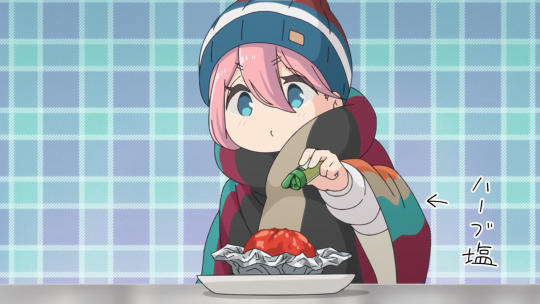
Our characters twice use Japanese-style herb salt in the course of making recipes, so we did our best to recreate it for you to use in these recipes since we couldn’t order any online. There is a particular brand of this herb salt which looks very close to the one used in the show, so we used that as the basis for our version.
2 TBSP – Kosher Salt
1 TBSP + 1 TSP – Dried Oregano
1 TBSP + 1 TSP – Dried Basil
2 TBSP + 1 TSP – Dried Parsley
1/2 TBSP – Garlic Powder
1/2 TBSP – Rubbed Sage
1 Cube – Vegetable Bouillon
1 TSP – Celery Seed
Crush the bouillon cube into a powder.
Mix with all the other ingredients and store in a spice container.
#anime#anime food#anime foodies#nos anime#camping#food#yuru camp#yurucamp#laid back camp season 2#camping food
10 notes
·
View notes
Text
Vegetables Roasted in Foil (Indeterminate Servings)

We bring you this recipe from our panel, “Anime Foodies: Laid-Back Camp Season 2”.
On her first solo-camping trip in Episode 8, Nadeshiko’s supper isn’t a single dish, but a bevy of various vegetables wrapped in foil and cooked by surrounding coals. As the vegetables finish, she takes them out of the coals, dresses them, and devours them. While one of the few recipes in the show to include exact time and ingredients, there is definitely some modification required to make everything work.
1 Pack – Gummies (Any Kind)
1 Small – Russet Potato (Yukon Gold)
1 Thin, Baking-Sized – Japanese Sweet Potato (Sweet Potato)
1 Large – Carrot
1 Head – Garlic
1 Medium – Hass Avocado
1 Small and Thin – Eggplant
1 Small – Sweet Red Apple
1 Medium – Tomato
To Taste – Japanese-Style Herb Salt
To Taste – Extra Virgin Olive Oil
Prepare your coals or campfire. Prepare coals as you would for grilling and, for the campfire, ensure the wood has burned down to hot coals and is no longer actively on fire.
Wash any of the vegetables for which you’ll be eating the skin.
Wrap the potato, sweet potato, and carrot in wet newspaper.
Wrap everything in a layer of heavy duty aluminum foil and place around the hot coals.
For the gummies, place these in the fire, count to ten, and remove.
For the potato, sweet potato, and carrot, cook in the coals for 30 minutes making sure to turn them and move them around at least four times during the time to ensure even cooking.
For the garlic, cook in a cooler portion of the coals for 30-45 minutes – depending on the size of the head of garlic – making sure to spin it at least four times to ensure even cooking. You will know it’s done when a toothpick will pass through the head from the outside smoothly.
For the avocado and eggplant, cook in the coals for 20 minute making sure to turn them and move them around at least a couple of times to ensure even cooking.
For the apple and tomato, cook in the coals for 25 minutes making sure to spin them at least four times to ensure even cooking.
Once removed, everything except the tomato is shown eaten plain. The tomato is dressed with Japanese-style herb salt and extra virgin olive oil before eating.

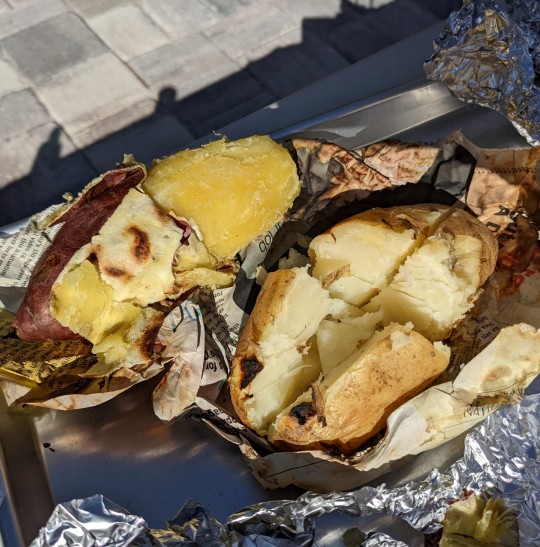

Optional/Notes:
If you cannot find those big juicing carrots, take two of the larger carrots you’ll typically get in the grocery store for cooking and wrap them together in a single packet before cooking in the coals.
If you do not have access to a Japanese-style herb salt, our recipe for one can also be found on our Tumblr page here.
You can lightly split the head of garlic before wrapping to help heat penetrate the head and allow for slightly faster cooking.
Given your inevitable proximity to an extremely hot grill or fire, ensure you have a long pair of tongs or a full length heat-resistant glove for handling the vegetables.
The gummies will be extra sticky when coming out of the fire, so be wary.
The show notes dressing the vegetables prior to consumption, but this is only shown with the tomato. Salt and pepper would be a good addition to the more savory vegetables. The Japanese-style herb salt is tasty with the garlic and eggplant. Butter would be a nice option with the potato or sweet potato. Butter and some brown sugar would go swell with the apple to make it richer and sweeter.
#anime#anime food#anime foodies#camping#nos anime#food#yurucamp#yuru camp#laid back camp season 2#camping food#laid back camp the movie
7 notes
·
View notes